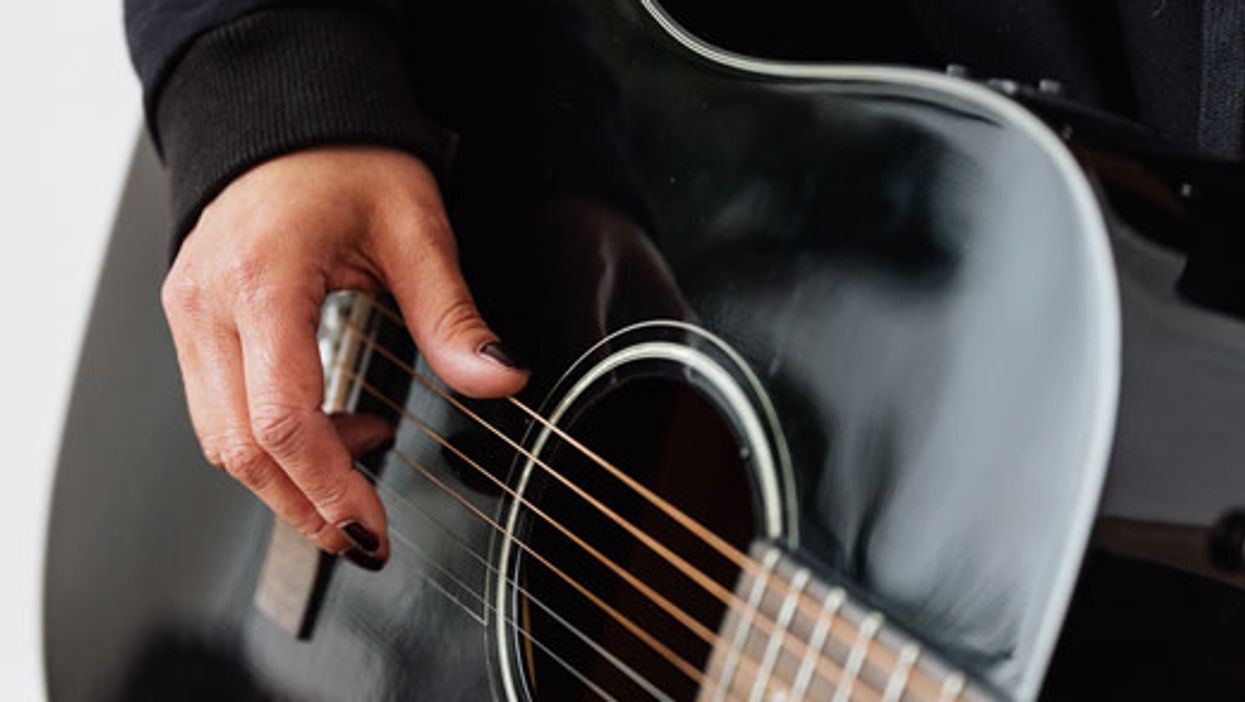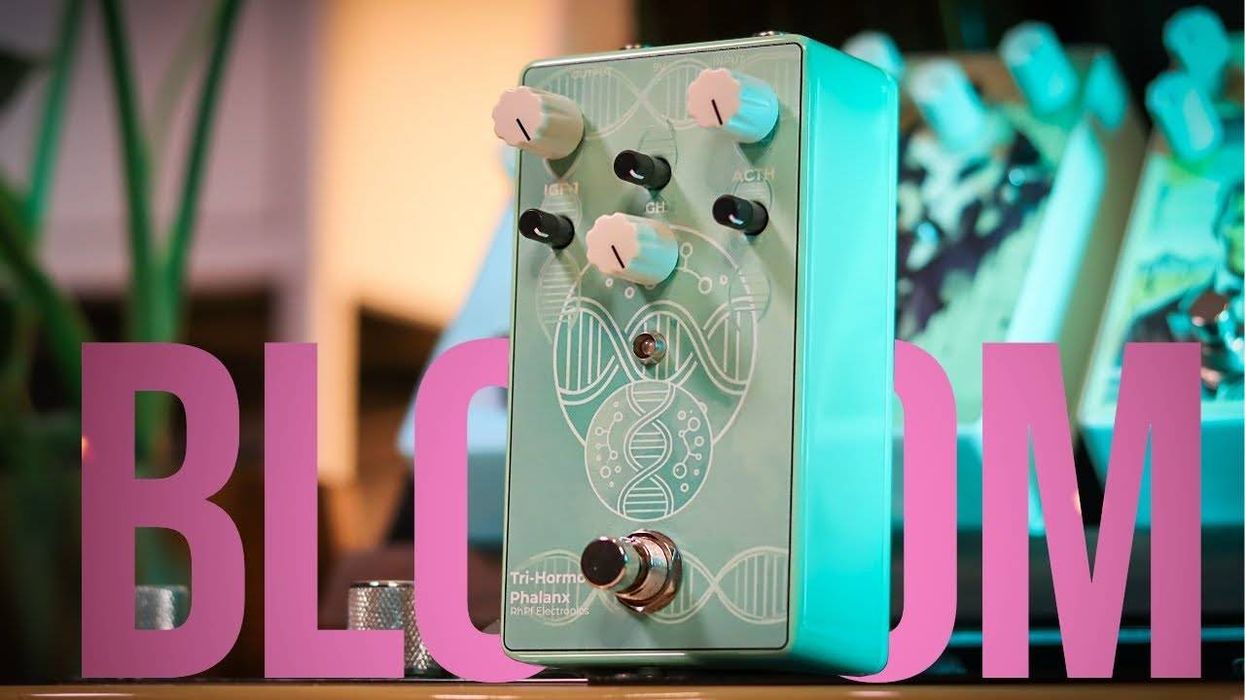Chops: Intermediate Theory: Beginner Lesson Overview: • Learn a three-step process to mastering a sound used by some of the greatest blues players of all time. • Develop your fingerstyle, thumbpick, and hybrid-picking techniques with the same song. • Learn to pedal bass notes while simultaneously improvising melodies and lead lines on top. Click here to download a printable PDF of this lesson's notation. |
One of the most satisfying ways of playing solo blues guitar is pedaling a consistent bass-note rhythm while simultaneously improvising lead lines and melodic phrases on top. Many of the blues greats like Big Bill Broonzy, Robert Johnson, Skip James, and Hubert Sumlin all employed this classic technique in their playing. Early country blues players would often use this pedal-style backing between vocal stanzas to create full and interesting guitar parts. Using their guitar alone, they were able to keep the energy of the music driving along without—and way before—looper pedals.
To start playing in this style, practice pedaling bass notes to create your own backing rhythm. The benefits are increased rhythmic independence, a deeper sense of basic time and groove, and getting a full, “band like" sound when playing solo guitar.
Before diving into the musical examples below, here's a refresher on the various techniques used in the picking hand and some general guidelines for practicing this style of guitar playing. All of these examples can be played fingerstyle (no pick), thumbpick, or hybrid-picking. Long term, you should be able to play them with all of those techniques, but to start, you should only use one. I would recommend starting with the technique closest to your common playing style.
If you primarily play with a flatpick, then you should play the bass notes with your pick and the alternate melodies with your middle and ring fingers in a hybrid style. If you play fingerstyle or with a thumbpick, then have your thumb play the bass notes while your index and middle fingers handle the alternate melodies.
The first time you try to play something like this it may seem very difficult. I recommend isolating the parts using this simple, three-step process:
Step 1: Play only the bass part until it is comfortable.
Step 2: Play only the alternate melodies until those are comfortable.
Step 3: Slowly put them together beat-by-beat and bar-by-bar. Count out loud if you need to.
Let's listen to a 12-bar blues in this style, and then break it down by applying the above three-step process.
Let's examine this four measures at a time. First, we are going to isolate the bass part, which is just eighth-notes on an open 6th string (Ex. 1). The eighth-notes are swung and the bass part is played palm-muted in this entire example. Palm-muting the bass part will distinguish it from the alternate melodies, which also contributes to developing that fuller band-like sound.
Click here for Ex. 1
In Ex. 2, we isolate the alternate melody and harmony only. Remember, if you're using a pick, these notes should be played with the middle and ring fingers of your picking hand. If you are playing fingerstyle or with a thumbpick, these parts should be played with your index and middle fingers.
Click here for Ex. 2
In Ex. 3, put the parts together very slowly. Remember the bass part must stay steady and separate from the alternate melody and harmony. This is where you'll really start to develop your independence muscle. Notice that this is a two-measure figure that is repeated to make up the first four measures of our 12-bar blues.
Click here for Ex. 3
Let's look at the bass line for the next four measures of this blues. In measures 5-8 of a standard blues progression, you will typically have two measures of the IV chord followed by two measures of the I chord. In measure 5, notice the bass note has shifted from the 6th string to the 5th string for the root note in Ex. 4. This is the root note for our IV chord, A, and then in measure 7, it moves back to the 6th string for our I chord, E. At the end of measure 8, there is a walk up that leads into the final four measures of this blues. Make sure you keep the bass palm-muted until after beat 4.
Click here for Ex. 4
Once the bass part in Ex. 4 is feeling comfortable, try Ex. 5. Here we see a familiar riff, but this time it's transposed to the IV chord (A) for two measures and then goes back to the same riff for the E chord for two measures.
Click here for Ex. 5
Now let's put them together slowly in Ex. 6. If you're having trouble, go even slower and try counting eighth-notes out loud as you play.
Click here for Ex. 6
Finally, let's look at Ex.7, which takes us through the last four measures of this blues. Remember how we walked up on the 5th string during measure 8? This walk up leads into the V chord in measure 9, which is B. We will keep our eighth-note bass groove going here. Next, move to the chord hit and double-stop lick in measure 10. Lastly, finish with a down-home blues style turnaround lick based off an open position E7 chord shape.
Click here for Ex. 7
Notice how Ex. 7 departs from the consistent pedal-tone bass part in the last three measures. This is totally acceptable, and the same approach used by many legendary blues guitarists. They would play a consistent bass part a lot of the time but would often veer off and play lead lines or blues turnaround phrases. Eventually, this should be your goal. Ex. 8 puts it all together.
Click here for Ex. 8
When you've completed these exercises, you should be able to hold down the bass part while playing the melody and harmony independently. However, don't feel locked in to playing every bass eighth-note throughout your blues progression. Keep it steady, and when you feel it, don't be afraid to veer off and experiment with soloing to make it your own!

















